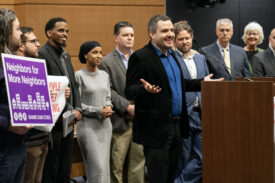 I doubt that most residents of leafy suburbs paid a lot of attention to air quality when they chose their homes. But it’s not hard to believe that, when suburban commuters return home from work each night, they breathe a little easier in the belief that they’ve escaped the smog and fumes of the city.
I doubt that most residents of leafy suburbs paid a lot of attention to air quality when they chose their homes. But it’s not hard to believe that, when suburban commuters return home from work each night, they breathe a little easier in the belief that they’ve escaped the smog and fumes of the city.
Only, maybe they haven’t. At least, not in the greater Puget Sound, anyway.
The Puget Sound Clean Air Agency maintains a network of air monitoring stations throughout the region. Some are in central Seattle, some in smaller cities, and some in suburbs and rural locations. And—perhaps surprisingly—there doesn’t appear to be a decisive air quality advantage to living in the suburbs. (See this pdf for more details.)
Or, to be a little more accurate: air quality tends to be both highly variable and very localized. Monitoring stations in the neighborhoods surrounding Seattle’s downtown tend to report that the air is pretty clean—cleaner, in some cases, than at more suburban monitoring stations in Bellevue, Lynnwood, or Lake Forest Park. On the other hand, the air in Seattle’s industrial zones can be pretty dirty; but then again, so can the air in Kent and Marysville.
The Beacon Hill monitoring station, a mile or so southeast of downtown Seattle, is worth a special mention.
The Beacon Hill neighborhood is just to the east (i.e., downwind) of I-5, the heavily trafficked West Seattle Bridge, and the Port of Seattle; to the north it’s bordered by I-90. Given its location, you might expect the air quality on Beacon Hill to be pretty bad. In fact, if you had to pick one residential neighborhood in Seattle that’s likely to have outdoor air quality problems, Beacon Hill might well be it.
But Beacon Hill’s air is, surprisingly, pretty clean. For fine particulate matter (i.e., soot, largely from diesel vehicles), it does moderately well: 3rd best of 7 regional monitoring stations by one measure, 7th of 16 by another, best among 5 by yet another. It has less ozone than any other monitoring station in the region (not surprisingly, as concentrations of ground-level ozone are typically lower in city centers than in leafy suburbs and exurbs). And its carbon monoxide levels were the lowest among 7 stations. I’m not sure why Beacon Hill does as well as it does—perhaps it’s just a function of altitude and prevailing wind patterns. But whatever the reason, it’s good news for the people who live there.
Clearly, the monitoring station results don’t offer definitive proof that Beacon Hill residents have nothing to worry about from their air. But it does mean that a move from Beacon Hill to, say, Lynwood or Bothell or Lake Forest Park or Marysville-all suburban locations-won’t necessarily buy cleaner air.
Three more points are worth mentioning here. First, as we mentioned in this post, the air in your car is typically among the worst you’ll breathe all day. Second, for most pollutants, indoor air is more polluted than outdoor air—and most people spend 90% or more of their time indoors. And third, outdoor air quality seems to have improved pretty substantially since the early 1980s; King County has had no “unhealthy” air quality days since 1999, and only 31 days in 6 years in which the air has been “unhealthy for sensitive groups.” That’s not a perfect record, obviously, but it does represent a substantial improvement from where we once were.
To me, these facts suggest that at this point improving the air that you breathe depends, in large measure, on keeping yourself off the highway, and keeping hazardous products out of your home. Obviously, clean outdoor air matters too—it’s just that living in the suburbs doesn’t necessarily guarantee that you’ll get it.
Update: I should mention that "A Beacon In The Smog" is, or at least was, the official tag line of Grist Magazine. Plagiarism, like imitation, is a sincere form of flattery.








